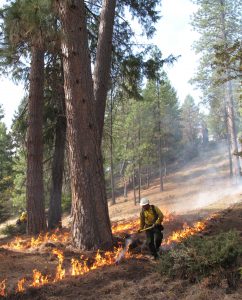Photo by Trinity County Resource Conservation District
Fire adapted communities are built on the concept that everyone in a community — from landowners to residents to government agencies to businesses — has a role to play in living more safely with wildfire. While homeowners and residents are expected to maintain defensible space around their homes, government agencies are generally responsible for leading community wildfire protection planning efforts. But who does the grueling and dirty work of implementing fuels reduction projects across public and private landscapes? Who assists landowners with projects requiring heavy labor or special equipment? Who runs the saws to maintain fuel breaks along strategic roads and ridgelines, working through the bitter winter, burning those countless piles? Who implements prescribed burns to reduce surface fuels, protect communities, and restore landscapes? The answer to this question, as is with many questions, is: “It depends.” Regardless of who does the work, a few things are certain: This is hard work. It’s honorable work. Lastly, it’s work that is often underappreciated and misunderstood.

Photo Credit: Lenya Quinn Davidson
The National Cohesive Wildland Fire Management Strategy and many creative government, nonprofit, and tribal leaders around the West are working to ensure that whenever possible, local community members do this work. These are, after all, the folks who live in the communities at risk and rely on the surrounding, healthy landscapes for their well-being. Despite what seems like an endless need for fire hazard reduction and forest restoration, it is far more challenging than you might think for local agencies to create high quality, decent paying jobs. There is a vision of a cross-trained local workforce, one that includes businesses, nonprofits and local fire service members working together across the three Cohesive Strategy goals on both public and private lands, before, during and after wildfires. This vision makes intuitive sense, but the challenges to its actualization are complex and numerous.
For one, fire suppression and emergency response drive funding, labor costs and industry structure. These variables have created a well-trained, rapidly deployable and highly mobile private contracting workforce. As part of their business model, these companies generally compete for off-season forestry services and fuels reduction contracts to supplement their primary fire suppression income. Federal land management agencies help to sustain this highly efficient and low-cost workforce through regional “indefinite duration, indefinite quantity” (IDIQ) contracts. While tools such as IDIQs play a critical role in the workforce puzzle, local organizations struggle to financially compete, and they often do not wish to function across the broader geographic areas typically serviced by IDIQ contracts. Beyond this driving force in federal procurement, there are myriad of other challenges for local organizations seeking to build integrated forest and wildfire management capacity. While grant funding and cooperative agreements are more flexible and accessible tools for local workforces, successfully capturing enough funding across seasons and year-to-year is a juggling act, if not prohibitive.
While the challenges to creating a viable, local FAC workforce are both systemic as well as place-specific, local, federal and state agencies, as well as local groups around the country, are finding creative and innovative ways to make it work. Over the last year, the FAC Net partnered with the Ecosystem Workforce Program at the University of Oregon to further explore this issue and document innovative examples of organizations navigating the maze of local, state and federal funding opportunities, programs and procurement strategies to build the local FAC workforce. Check out our just-released “Local Capacity for Integrated Forest and Wildfire Management” Working Paper to understand some of the most successful pathways in building that workforce.
And join us in honoring the hard work of our friends and neighbors who are laboring away in our forests, woodlands and rangelands, increasing our communities’ and our landscapes’ wildfire resiliency. They deserve stable jobs, fair pay, safe and productive working conditions, and our respect and support!
Please note that comments are manually approved by a website administrator and may take some time to appear.



Here’s a related resource: How can we better support community-based environmental stewardship in readiness, response, and recovery from disturbance? http://www.thenatureofcities.com/2016/11/06/resilience-isnt-only-about-infrastructure-how-can-we-better-support-community-based-environmental-stewardship-in-readiness-response-and-recovery-from-disturbance/